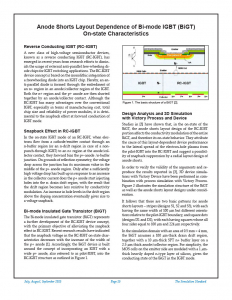Anode Shorts Layout Dependence of Bi-mode IGBT (BiGT) On-state Characteristics
Reverse Conducting IGBT (RC-IGBT)
A new class of high-voltage semiconductor devices, known as a reverse conducting IGBT (RC-IGBT), has emerged in recent years from research efforts to diminish the usage of external anti-parallel free-wheeling diode chips for IGBT switching applications. The RC-IGBT device concept is based on the monolithic integration of a freewheeling diode into an IGBT chip. Hereby, an anti-parallel diode is formed through the embedment of an n+ region in an anode/collector region of the IGBT. Both the n+ region and the p+ anode are then shorted together by an anode/collector contact. Although the RC-IGBT has many advantages over the conventional IGBT, especially in terms of manufacturing cost, total chip size and reliability of power modules, it is detrimental to the snapback effect at forward conduction of IGBT mode.
Snapback Effect in RC-IGBT
In the on-state IGBT mode of an RC-IGBT, when electrons flow from a cathode/emitter contact through an n-buffer region (or an n-drift region in case of a non-punch-through IGBT) to an n+ region at the anode/collector contact, they forward bias the p+-anode /n-buffer junction. On grounds of reflection symmetry, the voltage drop across the junction has its maximum value in the middle of the p+ anode region. Only after a sufficiently high voltage drop has built up in response to an increase in the collector current does the p+ anode start injecting holes into the n- drain drift region, with the result that the drift region becomes less resistive by conductivity modulation. An increase in hole levels in the drift region above the doping concentration eventually gives rise to a voltage snapback.



